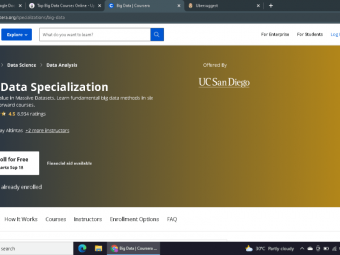Electronics Week 01
Tags: Electronics
Intro to Electronics: Learn about bonding, conductors, insulators, terminology & schematic symbols (Semester 1, Week 1)
Last updated 2022-01-10 | 4
- You will be able to identify atoms as conductors- semiconductors or insulators.
- You will know why electrical current is the flow of free electrons.
- You will be introduced to schematic diagrams and and many schematic symbols
- and be able to identify several schematic symbols.
What you'll learn
* Requirements
* There are no prerequisites for this course. Math is limited to the ability to add* subtract
* multiply and divide whole numbers
* fractions and decimals using a calculator.
Description
The course:
This course is Week One of an Eight Week section titled "DC Electronics", which is the first semester of an eight semester program.
The main topics for this course are:
1. Starting at the atomic level, or, why we need to understand how electricity and electronics are driven by electrons.
2. The three things that make electronics work:
......Conductors
......Insulators
......Semiconductors
3. What is electrical/electronic current?
4. Intro to basic circuit terminology.
5. Overview of many schematic symbols
The Semester: (This course is week 1 of this eight week semester.)
These are the classes for this eight week semester:
1. Direct Current at the Molecular Level (This class)
2. Electrical Units; Volts, Ohms, Amps and Watts
3. Measuring Equipment
4. Basic DC Circuits; Voltage, Current, Resistance and Power
5. DC Circuit Analysis; Kirchhoff's Laws; Determining Resistance, Voltage, Current and Power in Series and Parallel Resistive Circuits
6. Resistors, Potentiometers, and Rheostats
7. Cells and Batteries
8. Magnetism and Magnetic Devices; Selonoids and DC Motors
The Program:
This course is part of the first semester, DC Electronics. Future semesters will include AC Electronics, Solid State Electronics (Transistors, FETs, MOSFETs and JFETs), Transistor and OpAmp theory, Communications Theory and Digital Electronics.
Who this course is for:
- This course is appropriate for teens through adults that desire to understand, analyze, design, repair and construct electronic circuits or projects.
- People who take electronics courses often go on to become electronics hobbyists, robotics hobbyists, electronics engineers, electronics test technicians or electronics repair technicians.
Course content
4 sections • 16 lectures
Electricity at the Molecular Level Preview 19:22
At the conclusion of this video:
1. You will have an introductory understanding of the Periodic Table of the Elements.
2. You will be able to name the parts of an atom and the charge (positive, negative or neutral) of each.
Electricity at the Molecular Level
The composition of atoms is reviewed
Charge and Bonding Preview 16:55
At the conclusion of this video, you will:
1. understand charge and that it is a lack or an excess number of electrons.
2. describe how atoms of different elements bond together.
Charge and Bonding
Units of charge and current flow are described.
Conductors, Insulators and Semiconductors, Part 1 of 2 Preview 19:58
At the conclusion of this video, you will understand that the number of electrons in the outer shell of any element is what gives that element the ability to conduct electricity.
Conductors, Insulators and Semiconductors
Electronics: Conductors, Insulators and Semiconductors Preview 19:52
At the conclusion of this video, you will understand the fundamental fact that electricity or electronics depends on the movement of charge (electrons) in conductive elements.
Conductors, Insulators and Semiconductors
Basic Circuit Terminology; The Anatomy of a Flashlight Preview 16:47
At the conclusion of this video, you will:
1. Have dissected a flashlight to learn the basic schematic symbols of its component parts.
2. understand that electricity and electronics depends on a complete circuit to perform work.
The Anatomy of a Flashlight
Schematic Symbols; Part 1 of 2 Preview 18:42
At the conclusion of this video, you will:
1. observe and be able to identify schematic symbols for basic electronic components.
2. be able to visually identify basic electronic components, such as resistors, capacitors and inductors, and
3. be able to draw the schematic symbol for each.
Schematic Symbols; Part 2 of 2 Preview 19:54
At the conclusion of this video, you will have completed a tour of many schematic symbols in use today, and be aware that you will be memorizing the symbols at a later date.








 This course includes:
This course includes:
















